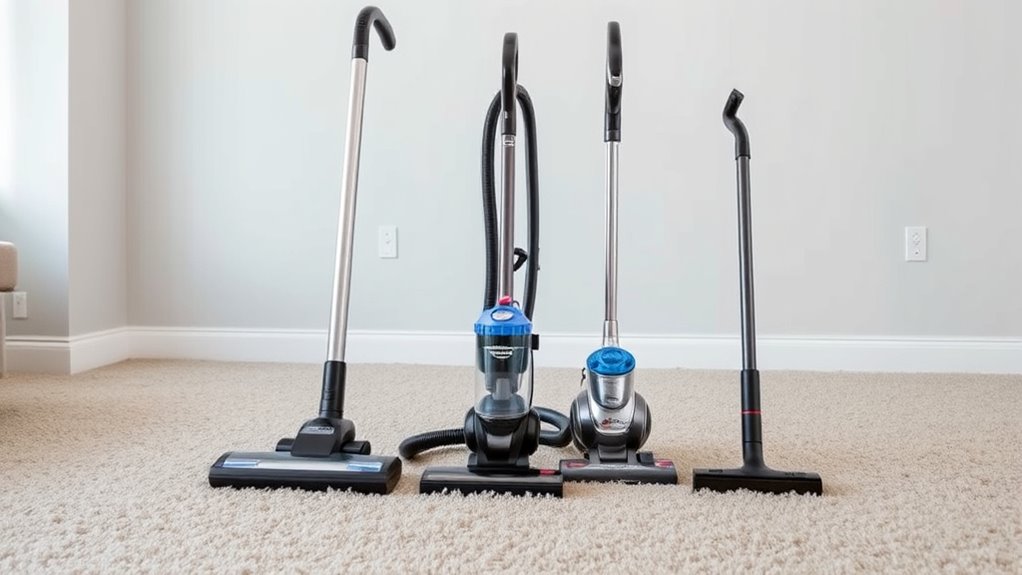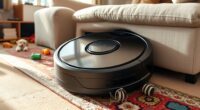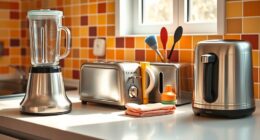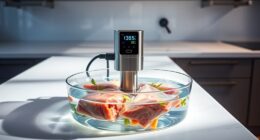Choosing the right vacuum depends on your home’s size, flooring, and cleaning habits. Upright vacuums work well for large areas and carpets, offering powerful cleaning but can be bulky. Canisters are versatile for mixed surfaces and tight spaces, though they’re a bit heavier to maneuver. Stick vacuums are lightweight and perfect for quick cleanups on hard floors. To find the best fit for your space, consider your needs—more details are just ahead.
Key Takeaways
- Upright vacuums are ideal for large, open spaces requiring powerful cleaning; canisters excel on varied surfaces and tight spots.
- Stick vacuums are lightweight and perfect for quick, daily cleanups, especially in small apartments or limited storage areas.
- Canisters offer better maneuverability around furniture and stairs, making them suitable for homes with complex layouts.
- Uprights typically provide stronger suction for deep carpet cleaning, while stick vacuums work well on hard floors.
- Consider your space, cleaning needs, and storage options to choose the style that best fits your home environment.
Comparing Design and Usability
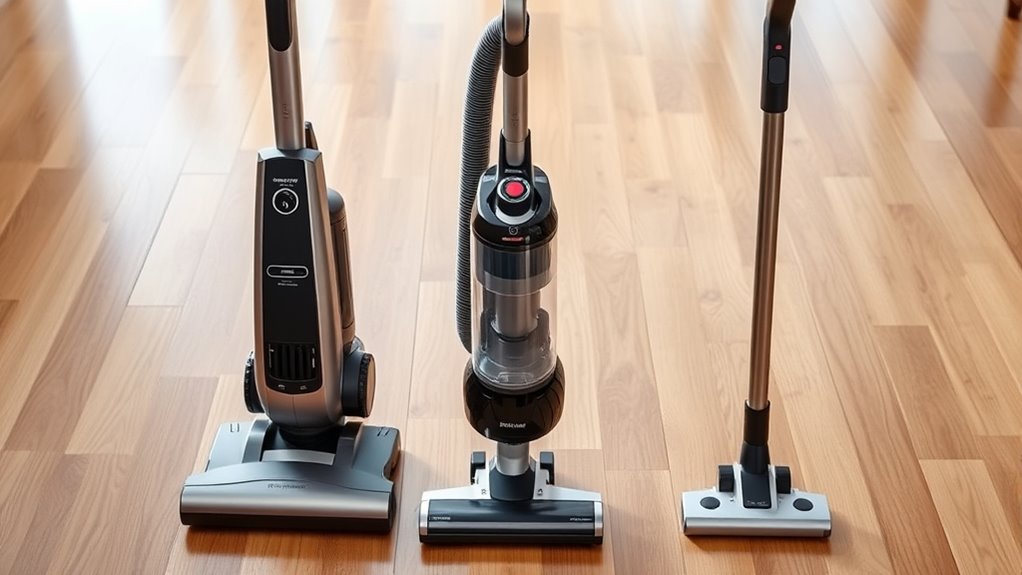
When comparing different vacuum styles, it’s important to contemplate both their design and how easy they are to use. Upright vacuums are bulky but straightforward, with a handle that makes pushing easy, ideal for quick cleanups. Canisters are more versatile, featuring a separate body and wand, which allows you to maneuver around furniture and reach tight spots effortlessly. Stick vacuums are lightweight and slim, perfect for quick, everyday cleaning, especially on hard floors. Consider how comfortable the vacuum feels in your hand, whether the controls are accessible, and if it’s easy to store. The design impacts your cleaning experience, so choose a style that aligns with your physical space and your ability to handle the device comfortably. Additionally, understanding projector technology can help you select the most suitable device for your home entertainment needs. Being aware of ergonomic design features in vacuum models can further enhance your comfort during use. For example, some models incorporate ergonomic handles and adjustable settings to reduce strain during extended cleaning sessions.
Evaluating Performance and Efficiency
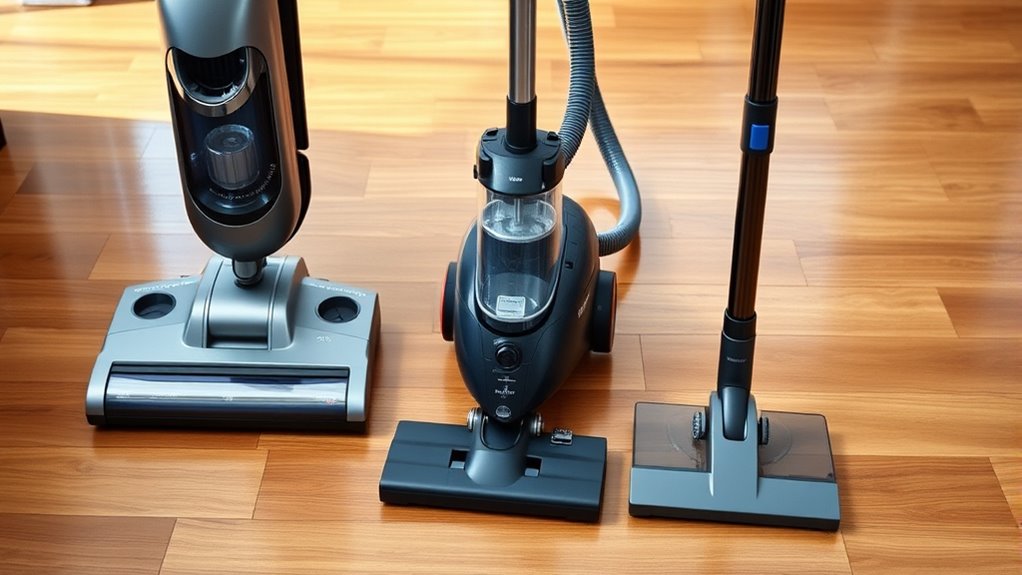
Evaluating a vacuum’s performance and efficiency involves examining how effectively it cleans and how quickly it gets the job done. You want a model that picks up dirt and debris thoroughly without requiring multiple passes. Look at suction power—strong suction indicates better cleaning, especially on carpets. Consider the airflow and brush design, which influence how well the vacuum lifts dirt from surfaces. Efficiency also means how long the vacuum can operate on a single charge or bag, minimizing interruptions. A lightweight model with good maneuverability saves you time and effort. Additionally, check if the vacuum handles different floor types seamlessly. Dog names can be a fun way to personalize your vacuum or other cleaning tools, making chores more enjoyable. Understanding vacuum performance metrics is essential for selecting a model that suits your needs. For example, some vacuums feature advanced airflow systems that enhance dirt pickup and overall efficiency.
Matching Vacuum Types to Your Living Space
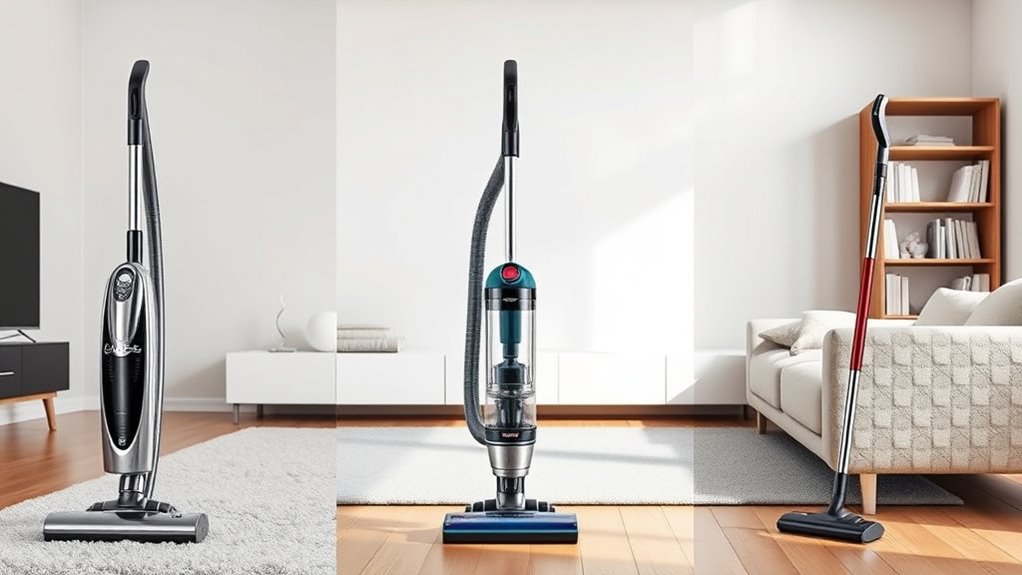
Choosing the right vacuum type depends on your living space’s size, layout, and flooring. If you have a large home with open areas, an upright vacuum offers powerful cleaning and wide coverage, making it ideal for carpets and hardwoods alike. For smaller spaces or apartments, a stick vacuum provides lightweight maneuverability and easy storage. If your home has a mix of surfaces, a canister vacuum can handle both with adjustable settings and versatile attachments. Consider your furniture and staircases—canister vacuums excel in traversing tight spaces, while uprights might struggle. Also, think about storage space; compact designs like sticks are easier to stow away. Matching your vacuum to your living space ensures efficient cleaning and avoids unnecessary hassle. Additionally, understanding vacuum tuning can help you select a model that maintains optimal performance over time. Being aware of maintenance requirements can also prolong your vacuum’s lifespan and ensure consistent results. Incorporating user reviews and expert opinions can guide you toward choosing a reliable model suited for your needs. Moreover, selecting a vacuum with advanced filtration can improve indoor air quality, especially if you or family members have allergies. Regularly checking and adjusting your vacuum’s components can further enhance its performance and longevity, ensuring it continues to serve your cleaning needs effectively.
Frequently Asked Questions
Which Vacuum Type Is Best for Pet Hair Removal?
A canister vacuum is best for pet hair removal because it offers powerful suction and flexible maneuverability, allowing you to reach tricky spots like stairs and upholstery easily. You should look for models with strong brushes and HEPA filters to trap allergens and hair effectively. Stick vacuums are lightweight but may lack the power needed for thorough pet hair cleanup, while uprights can handle larger areas but might be less versatile.
Are Stick Vacuums Suitable for Deep Carpet Cleaning?
Stick vacuums aren’t ideal for deep carpet cleaning because they typically have less suction power and shorter battery life. You’ll find they work best for quick cleanups on hard floors or low-pile carpets. For thorough deep cleaning, especially on shaggy or thick carpets, you should consider an upright or canister vacuum with stronger motors and more effective brushes. Stick vacuums excel at convenience but may fall short in deep cleaning tasks.
How Noisy Are Each Vacuum Style During Operation?
Upright vacuums tend to be the loudest, often producing noise levels around 75-85 decibels, which can be disruptive. Canister vacuums are usually quieter, ranging from 70-80 decibels, making them better for noise-sensitive environments. Stick vacuums are generally the quietest, often below 70 decibels, so you’ll find them less intrusive during cleaning. Your experience depends on the model and its motor power, but noise varies across styles.
Can Canister Vacuums Handle Large Debris Effectively?
Yes, canister vacuums can handle large debris effectively. Their powerful suction and flexible hoses make it easy to pick up big pieces from carpets, hardwood floors, or upholstery. You can easily maneuver around furniture and reach tight spots, ensuring thorough cleaning. Just make sure to use the appropriate attachments and keep the canister empty, so it maintains peak performance when tackling larger debris.
What Is the Typical Weight Difference Among These Vacuum Types?
Canister vacuums typically weigh around 10 to 15 pounds, making them lighter than upright models, which often weigh between 15 to 20 pounds. Stick vacuums are usually the lightest, often under 8 pounds, offering easy maneuverability. This weight difference impacts how you handle and store your vacuum, with lighter models being more portable for quick cleans and heavier ones providing more powerful suction for deep cleaning.
Conclusion
Choosing the right vacuum depends on your home’s layout and cleaning needs. Did you know that 78% of homeowners find upright vacuums easiest for daily use, while canisters excel in versatility? By understanding each style’s strengths, you can make a smarter decision that saves you time and effort. So, consider your space and habits carefully—your perfect vacuum is out there, ready to make cleaning less of a chore and more of a breeze.
